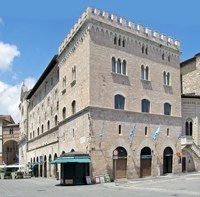
Monsignor Michele Faloci Pulignani, who restored the Duomo (in 1903-4) and the Palazzo dei Canonici (in 1923-5), established the nucleus of this collection. Canon Mariano Filippini subsequently added to it and opened it to the public. The museum re-opened in 2008 in the top two floors of the Palazzo dei Canonici, and has its entrance in the left aisle of the Duomo. It is also possible to visit the Crypt of the Duomo
Works from the Duomo
The following works from the Duomo were mostly removed prior to the remodelling of the nave in 1771.
St Felician (ca. 1425)
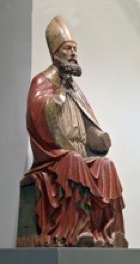
Altarpieces from the Chapels demolished in 1771
Annunciation (ca. 1599)
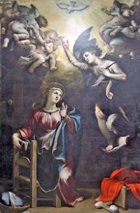
Miracle of St Martin of Tours (ca. 1603)
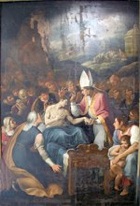
The altarpiece depicts St Martin reviving from the dead a catechumen (a young man studying in preparation for baptism) so that he could be baptised.
Marriage of the Virgin (1613)
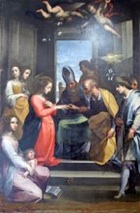
SS Cosmas and Damian (ca. 1636)

Martyrdom of SS Crispin and Crispinian (ca. 1640)
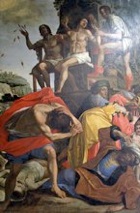
The altarpiece is attributed to Cesare Sermei: preparatory sketches that are almost certainly his work survive in Assisi. It was probably painted between 1635, the year in which the stucco decoration of the altar was executed, and 1642-4, when it was gilded.
Altarpieces from Other Chapels in the Duomo
Madonna and Child in glory with saints (1598)
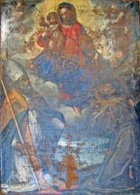
The altarpiece was cut down and badly damaged in 1771, when it was moved to the sacristy. It depicts the Madonna and Child seated on clouds while SS Felician and Francis below commend the city to their care.
Coronation of the Virgin and saints (1626)
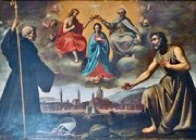
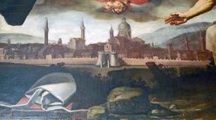
In 1626, Ludovico Jacobilli requested permission from the Cathedral Chapter to place “il quadro del Beato Pietro Crisci” in the Cappella di San Domenico di Sora e il Beato Pietro Crisci (later the Baptistery) in the Duomo. (At this time, the chapel contained the relics of the Blessed Peter Crisci). This was almost certainly this panel in the museum, which is attributed to the French artist Noel Quillerier. It depicts the Virgin looking down on Foligno while Christ and God the Father hold a crown above her head. St Dominic of Sora and the Blessed Peter Crisci commend the city to her care.
Trinci Corridor
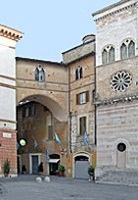
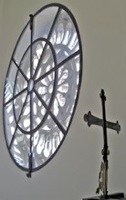
A number of exhibits relating to the structural history of the Duomo are arranged in the corridor behind the rose window on the left of the minor facade of the Duomo, which linked Palazzo Trinci to the Palazzo dei Canonici.
Cross from the Campanile (1438)
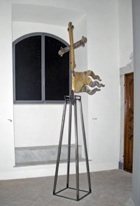
Door from the Duomo
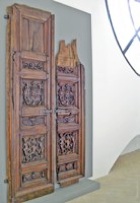
Architectural fragments from the Duomo (9th century)

This architectural fragment is the object (then in the crypt of the Duomo) that was described by:
-
✴Luigi Sensi (referenced below, at p. 317 and Figures 9 and 10); and
-
✴Paola Guerrini and Francesca Latini (referenced below, at p. 129; at p. 291, entry 66; and as Figure 60).
Luigi Sensi believed that it had been found during the restoration of the Duomo in 1903-4. He suggested that it had originally formed part of a transenna (a screen around a shrine in early Christian architecture) and dated it to the 9th century. Paola Guerrini and Francesca Latini (referenced below, at p. 291) characterised it as a cornice, and hypothesised that it came from an otherwise undocumented shrine on the site of the Duomo, presumably the martyrium of St Felician.
Note that the only other evidence for this putative early sanctuary is in the form of a column re-used in the loggia of the minor facade. No evidence survives of any other religious building in the centre of Foligno at this early date, although a number of suburban churches seem to have existed at this time. In particular, a larger number of architectural fragments embedded in the wall of the cloister of Santa Maria in Campis are evidence for an early church on this site.
Architectural fragments from the Duomo (11th century)
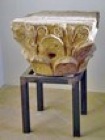
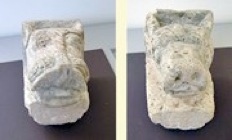
These fragments from the original Duomo, which were probably discovered in 1902-4, include:
-
✴the capital of a column; and
-
✴two protomes that probably came from the facade.
Roscioli Family Bequest
The family owed its social position to Bartolomeo Roscioli di Roccafranca, who was part of the circle of educated men around Cardinal Maffeo Barberini during his period as Archbishop of Spoleto (1608-17). When the cardinal was elected as Pope Urban VIII, Bartolomeo became the papal secretary. His son, Giovanni Maria Roscioli became the papal cupbearer in 1630 and Maestro di Camera del Papa (Papal Chamberlain) in 1643. He might well have became a cardinal had he not died prematurely in the following year.
Bartolomeo Roscioli began the family’s art collection, but its most important elements were added by Giovanni Maria, who was a noted collector. The collection passed to his two brothers, Vincenzo and Dionisio Roscioli, and (after the death of Dionisio in 1702) to their nephew, Giuseppe Salvi Roscioli. The family became extinct when he died in 1703, and he named as his universal heir the Cappella Roscioli in the Duomo (which was actually the area around and including the high altar). He wished for money raised from his estate to be used for the embellishment of this chapel. This was particularly needed after the earthquake of 1703.
Busts of Bartolomeo and Diana Roscioli (17th century)
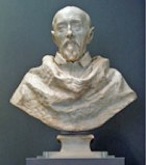
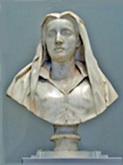
Giovanni Maria Roscioli probably commissioned these portrait busts of his parents in Rome. They were placed in the Roscioli chapel of the Duomo in 1709 and subsequently moved to niches in the sacristy. They were neglected by art historians until the early 20th century, when Michele Faloci Pulignani recognised them as works by Gianlorenzo Bernini.
The busts are attributed on stylistic grounds to different phases of Bernini’s career:
-
✴The bust of Bartolomeo Roscioli was probably executed at about the time of his death, in 1634.
-
✴The posthumous bust of his wife, Diana may well have been associated with a bequest made by Giovanni Maria Roscioli to Bernini when he died in 1644.
Crucifix (1635)
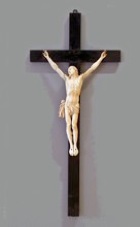
Copy of the Foligno Madonna (17th century)

Art from Other Churches
Virgin and St John the Evangelist (ca. 1463)
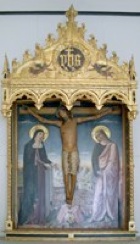
The confraternity took the tabernacle with them in 1569 when they moved to the Oratorio della Misericordia. It was moved to the sacristy of the Duomo in 1904.
Fresco fragment (1458)
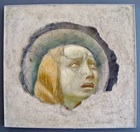
San Salvatore Polyptych (1432)
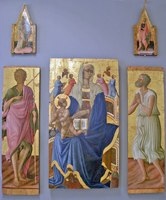

Detail of main panel
Rinaldo Trinci, Prior of San Salvatore, commissioned this altarpiece from Bartolomeo di Tommaso for the high altar of the church. It is the only surviving panel by this artist that remains in Foligno.
-
✴The central panel depicts the Madonna and Child enthroned, with a tiny figure of the kneeling Prior Trinci (bottom right, illustrated above).
-
✴The panels to the sides depict St John the Baptist and the Blessed Peter Crisci.
-
✴The panels from the top register exhibited here depict SS Bartholomew and Ursula.
Four other panels were sold in 1825, one of which (the central panel in the top register) has been lost. The other three, which formed the predella, have been identified as:
-
✴Christ’s agony at Gethsemane, in the Pinacoteca Vaticana, Rome;
-
✴the road to Calvary, in the Musée du Petit Palais, Avignon; and
-
✴the burial of Christ, in the Galleria Nazionale, Perugia.
Flight into Egypt (ca. 1432)
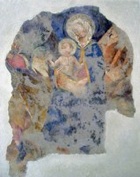
St Mary Jacobi (1507)
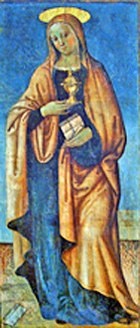
Altarpieces from Serrone di Foligno(ca. 1650)

-
✴the workshop of St Joseph (illustrated); and
-
✴the beheading of St John the Baptist.
Wooden Sculptures
Madonna and Child enthroned (early 13th century)
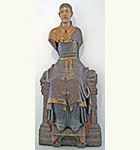
Madonna and Child enthroned (early 14th century)
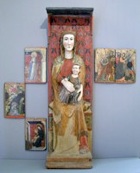
There were originally sixteen panels depicting eight scenes. Those recovered are:
-
✴the right panel from the “nole me tangere”;
-
✴the left panel from the agony in the garden;
-
✴the right panel from the presentation of Jesus at the Temple; and
-
✴the pair of panels depicting the capture of Christ.
Madonna and Child enthroned (early 14th century)
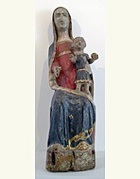
Crucifixes
Crucifix (ca. 1400)
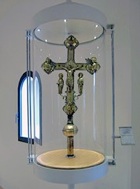
Monstrance (17th century)
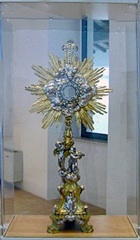
Crucifix (early 14th Century)
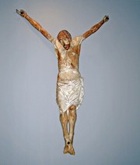
Crucifix (early 17th Century)
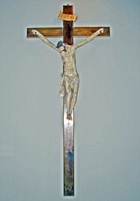
Fragment of a Crucifix (15 Century)
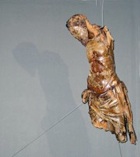
[On the right side of the Duomo, in a small space at the base of the campanile, there is a fragment of a sarcophagus (2nd century AD) that is said to have belonged to St Messalina, who was martyred with St Felician. ]
Read more:
P. Guerrini and F. Latini, “Dal Municipium Romano alla Civitas Medievale: Archeologia e Storia di una Città Umbra”, (2012) Spoleto
L. Sensi, “La Raccolta Archeologica della Cattedrale di Foligno”, Bollettino Storico della Città di Foligno, 9 (1985) 305-26
Return to the page on Museums of Foligno.
Return to Walk I.



